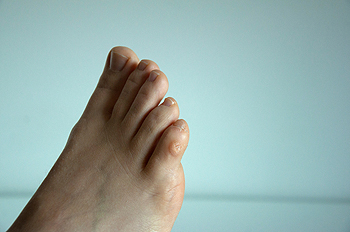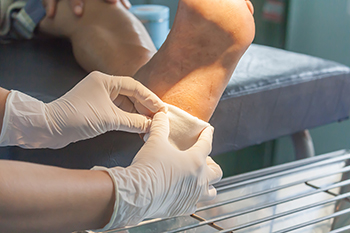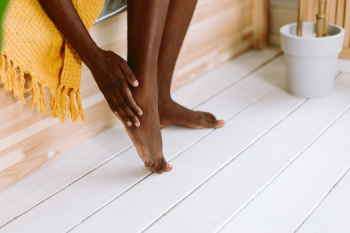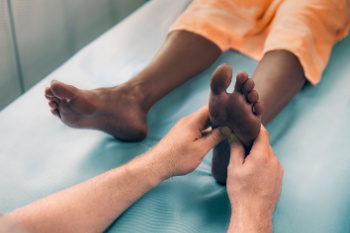Items filtered by date: May 2024
Professional Foot Corn Removal
 Corns are hard, thickened areas of skin that form on the feet in response to pressure and friction. They typically develop on the toes or the soles of the feet. These skin lesions can cause discomfort and pain, particularly when pressure is applied, such as while wearing shoes. Although corns form to protect the skin, they often grow too thick and need to be managed. A podiatrist, or foot doctor, can professionally remove corns through several methods. One common technique is carefully paring down the thickened skin using a scalpel. This should only be done by a professional to avoid injury. For persistent corns, a podiatrist may also use salicylic acid treatments to chemically pare down the excess skin. Additionally, custom orthotics or padding might be recommended to relieve pressure and prevent the recurrence of corns. In severe cases, a podiatrist may suggest surgical correction of the underlying bone structure that causes the friction. If you are struggling with foot corns, it is suggested that you visit a podiatrist for personalized and safe treatment.
Corns are hard, thickened areas of skin that form on the feet in response to pressure and friction. They typically develop on the toes or the soles of the feet. These skin lesions can cause discomfort and pain, particularly when pressure is applied, such as while wearing shoes. Although corns form to protect the skin, they often grow too thick and need to be managed. A podiatrist, or foot doctor, can professionally remove corns through several methods. One common technique is carefully paring down the thickened skin using a scalpel. This should only be done by a professional to avoid injury. For persistent corns, a podiatrist may also use salicylic acid treatments to chemically pare down the excess skin. Additionally, custom orthotics or padding might be recommended to relieve pressure and prevent the recurrence of corns. In severe cases, a podiatrist may suggest surgical correction of the underlying bone structure that causes the friction. If you are struggling with foot corns, it is suggested that you visit a podiatrist for personalized and safe treatment.
If you have any concerns regarding your feet and ankles, contact Cecilia Capuano-King, DPM of New York. Our doctor will treat your foot and ankle needs.
Corns: What Are They? and How Do You Get Rid of Them?
Corns can be described as areas of the skin that have thickened to the point of becoming painful or irritating. They are often layers and layers of the skin that have become dry and rough, and are normally smaller than calluses.
Ways to Prevent Corns
There are many ways to get rid of painful corns such as wearing:
- Well-fitting socks
- Comfortable shoes that are not tight around your foot
- Shoes that offer support
Treating Corns
Treatment of corns involves removing the dead skin that has built up in the specific area of the foot. Consult with Our doctor to determine the best treatment option for your case of corns.
If you have any questions please feel free to contact our office located in Smithtown, NY . We offer the newest diagnostic and treatment technologies for all your foot and ankle needs.
Healing of Foot Ulcers

Foot ulcers are open wounds that occur on the bottom of the foot or around the toes. They can range in size from small sores to larger, more severe wounds. These ulcers develop from a combination of medical factors, such as poor circulation, nerve damage, and high blood sugar levels, particularly in individuals with diabetes. Additionally, non-medical reasons like improper footwear, foot deformities, and injuries can contribute to their formation. Diagnosis involves a thorough examination by a podiatrist, often including tests to assess blood flow and nerve function. Foot ulcers differ from other skin conditions by their depth and potential to worsen if left untreated, leading to serious complications like infection or even amputation. If you have a foot ulcer, it is strongly suggested that you schedule an appointment with a podiatrist for prompt treatment, which may involve wound care, infection management, pressure relief, and addressing related underlying medical conditions.
Wound care is an important part in dealing with diabetes. If you have diabetes and a foot wound or would like more information about wound care for diabetics, consult with Cecilia Capuano-King, DPM from New York. Our doctor will assess your condition and provide you with quality foot and ankle treatment.
What Is Wound Care?
Wound care is the practice of taking proper care of a wound. This can range from the smallest to the largest of wounds. While everyone can benefit from proper wound care, it is much more important for diabetics. Diabetics often suffer from poor blood circulation which causes wounds to heal much slower than they would in a non-diabetic.
What Is the Importance of Wound Care?
While it may not seem apparent with small ulcers on the foot, for diabetics, any size ulcer can become infected. Diabetics often also suffer from neuropathy, or nerve loss. This means they might not even feel when they have an ulcer on their foot. If the wound becomes severely infected, amputation may be necessary. Therefore, it is of the upmost importance to properly care for any and all foot wounds.
How to Care for Wounds
The best way to care for foot wounds is to prevent them. For diabetics, this means daily inspections of the feet for any signs of abnormalities or ulcers. It is also recommended to see a podiatrist several times a year for a foot inspection. If you do have an ulcer, run the wound under water to clear dirt from the wound; then apply antibiotic ointment to the wound and cover with a bandage. Bandages should be changed daily and keeping pressure off the wound is smart. It is advised to see a podiatrist, who can keep an eye on it.
If you have any questions, please feel free to contact our office located in Smithtown, NY . We offer the newest diagnostic and treatment technologies for all your foot care needs.
Ankle Fracture? Don’t Wait for Treatment
Ankle Pain and Arthritis
 Ankle pain can be a symptom of various types of arthritis, each with distinct characteristics and causes. Osteoarthritis, often associated with aging, occurs when the protective cartilage cushioning the ends of the bones wears down over time. This leads to pain and stiffness in the ankle. Rheumatoid arthritis, or RA, is an autoimmune condition where the immune system mistakenly attacks the joints, including those in the ankle. Inflammation, swelling, and pain in the ankles are common symptoms. Gout, another form of arthritis, is caused by the buildup of uric acid crystals in the joints. This condition can lead to sudden, severe attacks of pain and redness in the ankle. There are different treatment strategies for each type of arthritis, including medication and lifestyle changes. In some cases, surgery may be necessary to relieve symptoms and improve joint function. A podiatrist, or foot doctor, can help diagnose the specific type of arthritis causing ankle pain through clinical evaluation and imaging tests. If you have ankle pain, it is suggested that you make an appointment with a podiatrist for diagnosis and a personalized treatment plan.
Ankle pain can be a symptom of various types of arthritis, each with distinct characteristics and causes. Osteoarthritis, often associated with aging, occurs when the protective cartilage cushioning the ends of the bones wears down over time. This leads to pain and stiffness in the ankle. Rheumatoid arthritis, or RA, is an autoimmune condition where the immune system mistakenly attacks the joints, including those in the ankle. Inflammation, swelling, and pain in the ankles are common symptoms. Gout, another form of arthritis, is caused by the buildup of uric acid crystals in the joints. This condition can lead to sudden, severe attacks of pain and redness in the ankle. There are different treatment strategies for each type of arthritis, including medication and lifestyle changes. In some cases, surgery may be necessary to relieve symptoms and improve joint function. A podiatrist, or foot doctor, can help diagnose the specific type of arthritis causing ankle pain through clinical evaluation and imaging tests. If you have ankle pain, it is suggested that you make an appointment with a podiatrist for diagnosis and a personalized treatment plan.
Ankle pain can be caused by a number of problems and may be potentially serious. If you have ankle pain, consult with Cecilia Capuano-King, DPM from New York. Our doctor will assess your condition and provide you with quality foot and ankle treatment.
Ankle pain is any condition that causes pain in the ankle. Due to the fact that the ankle consists of tendons, muscles, bones, and ligaments, ankle pain can come from a number of different conditions.
Causes
The most common causes of ankle pain include:
- Types of arthritis (rheumatoid, osteoarthritis, and gout)
- Ankle sprains
- Broken ankles
- Achilles tendonitis
- Achilles tendon rupture
- Stress fractures
- Bursitis
- Tarsal tunnel syndrome
- Plantar fasciitis
Symptoms
Symptoms of ankle injury vary based upon the condition. Pain may include general pain and discomfort, swelling, aching, redness, bruising, burning or stabbing sensations, and/or loss of sensation.
Diagnosis
Due to the wide variety of potential causes of ankle pain, podiatrists will utilize a number of different methods to properly diagnose ankle pain. This can include asking for personal and family medical histories and of any recent injuries. Further diagnosis may include sensation tests, a physical examination, and potentially x-rays or other imaging tests.
Treatment
Just as the range of causes varies widely, so do treatments. Some more common treatments are rest, ice packs, keeping pressure off the foot, orthotics and braces, medication for inflammation and pain, and surgery.
If you have any questions, please feel free to contact our office located in Smithtown, NY . We offer the newest diagnostic and treatment technologies for all your foot care needs.
Arthritis and the Feet

Arthritis affecting the feet requires diligent attention to maintain overall health and mobility. Foot care for arthritic individuals involves regular inspection for inflammation, keeping feet clean and dry, and wearing supportive footwear with custom orthotic inserts. Management of inflammation and pain through medication and therapy is important to prevent long-term complications like joint deformities and reduced mobility. Particular focus should be given to maintaining foot health to prevent secondary issues. If you have arthritis that is negatively impacting the comfort of your feet, it is suggested that you make an appointment with a podiatrist for a personalized treatment plan, which may include prescribing orthotics and offering guidance on foot care techniques.
Arthritis can be a difficult condition to live with. If you are seeking treatment, contact Cecilia Capuano-King, DPM from New York. Our doctor can provide the care you need to keep you pain-free and on your feet.
Arthritic Foot Care
Arthritis is a term that is commonly used to describe joint pain. The condition itself can occur to anyone of any age, race, or gender, and there are over 100 types of it. Nevertheless, arthritis is more commonly found in women compared to men, and it is also more prevalent in those who are overweight. The causes of arthritis vary depending on which type of arthritis you have. Osteoarthritis for example, is often caused by injury, while rheumatoid arthritis is caused by a misdirected immune system.
Symptoms
- Swelling
- Pain
- Stiffness
- Decreased Range of Motion
Arthritic symptoms range in severity, and they may come and go. Some symptoms stay the same for several years but could potentially get worse with time. Severe cases of arthritis can prevent its sufferers from performing daily activities and make walking difficult.
Risk Factors
- Occupation – Occupations requiring repetitive knee movements have been linked to osteoarthritis
- Obesity – Excess weight can contribute to osteoarthritis development
- Infection – Microbial agents can infect the joints and trigger arthritis
- Joint Injuries – Damage to joints may lead to osteoarthritis
- Age – Risk increases with age
- Gender –Most types are more common in women
- Genetics – Arthritis can be hereditary
If you suspect your arthritis is affecting your feet, it is crucial that you see a podiatrist immediately. Your doctor will be able to address your specific case and help you decide which treatment method is best for you.
If you have any questions, please feel free to contact our office located in Smithtown, NY . We offer the newest diagnostic and treatment technologies for all your foot care needs.

